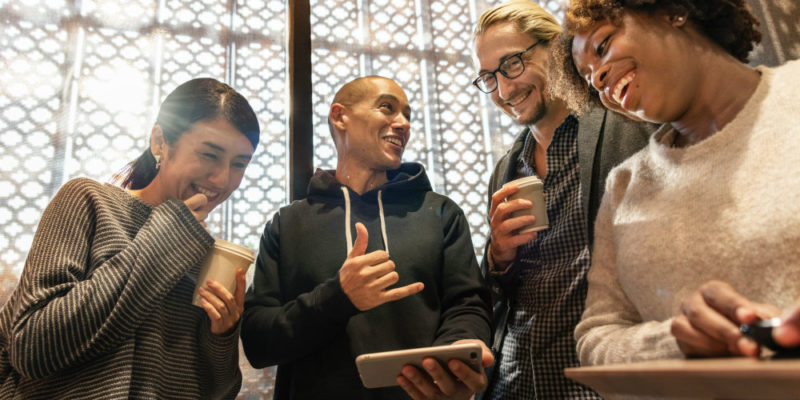Strengthen Your Marketing Through the Art of Anticipation

One thing connects every college grad: We all had to sit through yawn-inducing lectures.
We may have blamed our boredom on the subject matter, but in reality, a good speaker can make anything interesting if they know how to present. Unfortunately, most professors aren’t experts in marketing their subject.
If your marketing is reminiscent of a college lecture, you’re doing something wrong.
Ask Yourself “Is My Marketing Like This?”
If you haven’t built any anticipation or gotten your audience excited about your product, then the answer is: yes, you are a boring college lecturer. (Bummer.)
If you’re not getting your audience excited about your brand, you become another faceless, uninteresting company that people don’t want to engage with. Not only are you losing potential clients to more engaging brands, you’re also failing to bring new leads to the door.
You know your brand is thrilling and engaging; you know you have the solutions your audience is looking for. It’s time they see that, too – by harnessing the power of anticipation.
Just Look at Apple’s Marketing Strategy
Every year, millions of hardcore techies eagerly await Apple’s keynote presentation. Weeks before, Apple begins releasing dramatic teaser trailers to increase the anticipation.
The keynote itself, too, is turned into a true event – one that people from all over the world want to attend. This hype is one reason Apple is one of the most profitable companies in the world.
As a marketer, your job is to entice a prospect to come to you. And Apple? They have mile-long lines of people waiting at their doors the day a new product is released because Apple knows how to get people excited.
Apple, with their dramatic commercials and theatrical events, knows that our brains are wired to look for things that excite us – things that release that little chemical sitting in the frontal lobe of our brain: dopamine.
Tapping into that portion of the brain gets us stimulated and ready to learn more. And the more excited we are about a brand, the more we want to know about it. The more we want to know, the more we want to engage with that brand.
This sense of excitement also creates a sense of urgency – it’s why people sleep in tents outside the apple store when a new product is about to drop.
Everyone Hates Clickbait (But It Works)
In the early days of clickbait, viral websites like Buzzfeed, ViralNova, and Upworthy skyrocketed their traffic by creating curiosity gaps with headlines like “He Gave This Homeless Man His Jacket and Was Shocked At What Happened Next.”
There are mixed feelings about clickbait, but most people agree on one thing: it’s annoying.
Even so, it works, which only highlights the power of curiosity and anticipation (and our desire to avoid FOMO). Clickbait manufactures emotion. If you can do the same with your marketing campaigns (and deliver on the promises you make), you can draw in loads of new clients.
Should you write headlines that sound like clickbait? Of course not. Luckily, there are other ways to get similar results with your marketing campaigns without making your audience roll their eyes.
#1 Give Them A Taste Of What’s To Come
Hollywood blockbusters do this better than anyone with their teaser trailers. Heck, they even have teasers for their teasers.
“Coming this Summer. The movie critics everywhere are raving about. The best thriller since Jurassic Park.”
Hollywood (and Apple) invest outrageous amounts of money developing trailers and teasers because they know that when people get a taste of what’s to come, they’ll want the whole thing. You can apply this same strategy in your marketing.
If you have a new product, service or piece of content in the pipeline, develop a launch strategy that shares little previews of the product long before the release. Target it to the right crowd, and they’ll be waiting at your doors (literally or digitally) on launch day.
#2 Let Your Influencers Spread Anticipation
Influencers love being in the know before anyone else. The best influencers like to share a good thing when they see it and excel at getting their loyal followers excited, too.
Identify an influencer (or even a few) whose fans adhere closely to your ideal target audience and let them in on the project prior to launch.
A great example of an influencer who helps spread anticipation is Lewis Hilsenteger, who runs the massively popular YouTube channel Unbox Therapy. Lewis shows off new or soon-to-be-released tech products on his channel and millions of fans eat it up, giving the product much-desired exposure.
#3 Nab the Earlybirds
It’s not just influencers who like to get products first. There’s always a few everyday people who will gladly sign up for your newsletter, follow you on social media, or offer up other information to get early access, so indulge them.
Karen Kilgariff and Georgia Hardstark from the hit podcast My Favorite Murder do this right. They created a private group called the Fan Cult. Listeners pay to be part of the group; in exchange, they get first dibs on tickets for live shows and extra content like mini episodes that don’t get released to the public.
Private groups, soft launches, early access, and exclusive discounts are all great ways to reward your audience for forking over their contact info and pledging their loyalty. Everyone wants to feel special, so use it to your advantage.
#4 Follow Your Teaser With A Teaser
The critical part of anticipation marketing is keeping your prospects hooked. Don’t toss something out there only to let it die. You’ll gain a rep as a company that doesn’t deliver.
Instead, keep the teasers coming, adding a little more each time, and your prospects will follow you right up to the big reveal.
Video game companies like Rockstar do this to great success when releasing new games. More than a year before releasing their latest hit, Red Dead Redemption 2, they released a short trailer. Then, they showed snippets of gameplay. Then, they released review copies.
Finally, they released the game itself, breaking all the records. Not only did it break the record for number of pre-sales, it also pulled in over $725 million in three days–breaking the record for the biggest opening weekend in entertainment history. Yeah–entertainment history, meaning it beat the highest-grossing movie weekend in history, too.
#5 Bring the Fanfare
When it finally comes time for the big reveal, pay it off in a big way.
Pump up your promotions a few days before to let everyone know the time is now. Hold a few contests or giveaways in the days leading up to your launch. Use FOMO to your advantage – give folks a reason to be there day one, and create an atmosphere that suggests if they miss out, they’re missing out on something huge.
People want to be excited, so leverage those feelings, stir up the dopamine, and build a brand that gives the people want they want.
If you can master the art of anticipation, your audience won’t just be hanging on your every word – they’ll be lining up at the door.
Tim Cook Photo Source: Apple

